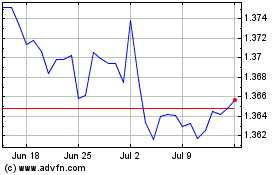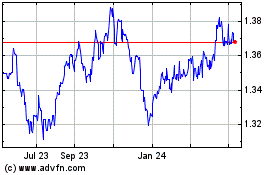German Industrial Output Rebounds; Exports Remain Flat
March 09 2020 - 4:31AM
RTTF2
Germany's industrial production rebounded at the fastest pace in
more than two years, while overall exports remained unchanged in
January as shipments to China went down, data from Destatis
revealed on Monday.
However, the outlook remains bleak as the coronavirus, or
COVID19, has hurt economic activity in a big way and caused supply
chain disruptions across the world. At the start of the week, the
government announced support measures for companies and
workers.
Industrial production grew 3 percent on a monthly basis,
reversing a revised 2.2 percent drop in December. Production was
forecast to grow moderately by 1.7 percent. This was the biggest
growth since November 2017.
At the same time, industrial output fell 1.3 percent from last
year, but slower than the 5.3 percent decrease logged in December,
and the expected annual fall of 3.8 percent.
Excluding energy and construction, industrial production was up
2.9 percent. Energy production slid 0.2 percent, while construction
output increased 4.7 percent due to mild weather.
In spite of the recently more favorable development of incoming
orders and the business climate, the outlook for the manufacturing
industry remains uncertain due to the new risks from the spread of
the Corona virus, the economy ministry said.
Ralph Solveen, a Commerzbank economist said, despite the good
start, GDP is likely to decline in the first quarter, in particular
as parts of the previously very stable service sector are currently
suffering massively from the spread of the coronavirus.
The grand coalition of Chancellor Angela Merkel decided to
increase investments by EUR 3.1 billion in each of the years from
2021 to 2024.
"As a result of the coronavirus, no company in Germany should go
bankrupt, nor should any job be lost as much as possible," the
coalition said in a statement on Monday. The measures were decided
after talks late Sunday.
The coalition also lowered the threshold for companies to claim
short-term work benefits.
Separate data from Destatis revealed that exports remained
unchanged in January, while imports recovered after falling for two
straight months.
Exports remained flat in January from December, when shipments
were up 0.2 percent. Economists had forecast exports to grow 0.8
percent.
Meanwhile, imports advanced 0.5 percent, following a 0.3 percent
drop in December. Imports were forecast to gain 0.6 percent.
Consequently, the trade surplus declined to a seasonally
adjusted EUR 18.5 billion from EUR 19 billion a month ago.
Exports to China decreased 6.5 percent and imports from China
fell only 0.5 percent. However, the results available so far do not
clearly show any coronavirus effect, Destatis said.
On a yearly basis, exports and imports fell 2.1 percent and 1.8
percent, respectively. As a result, the trade surplus decreased to
an unadjusted EUR 13.9 billion from EUR 14.5 billion in the
previous year.
Further, data showed that the current account surplus dropped to
EUR 16.6 billion from EUR 17.6 billion in the same period last
year.
US Dollar vs CAD (FX:USDCAD)
Forex Chart
From Mar 2024 to Apr 2024

US Dollar vs CAD (FX:USDCAD)
Forex Chart
From Apr 2023 to Apr 2024
